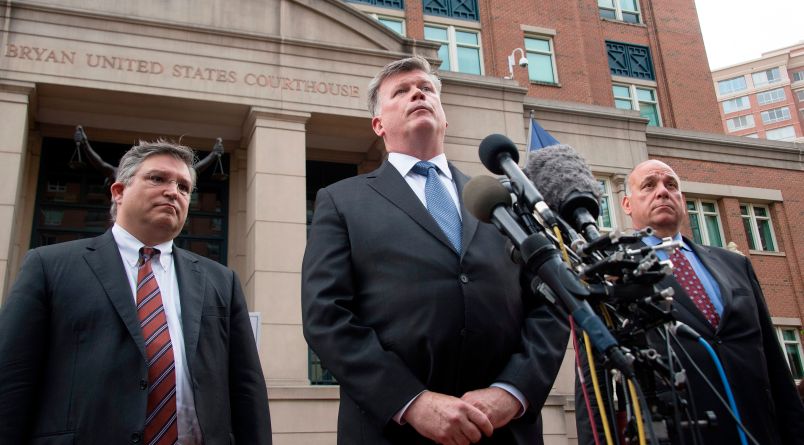After four days of deliberation on the tax fraud and bank fraud charges against Paul Manafort in the Virginia trial, the jury revealed Tuesday that it was hopelessly deadlocked on 10 of the 18 counts he faced, all of which related to charges on bank fraud and failure to report foreign bank reports. It was on these counts that the defense focused its efforts to persuade the jury that the government failed to make its case and the 10 mistrial counts suggest that the defense was somewhat effective in those areas.
Manafort’s attorneys did not offer much of a defense in the trial — they rested their case without calling any of their own witnesses and they offered only a handful of exhibits throughout the weeks-long trial. The defense team did not use one overarching point to make their case, aside from their attempts to blame everything on Manafort’s former deputy, Richard Gates, and Manafort’s accountants. Instead, they used their cross-examination of the prosecution’s witnesses and their closing argument to muddy the water and plant seeds of doubt in jurors’ minds. Given the 10 mistrial counts, it appears they were relatively successful.
The defense’s most effective cross-examinations came in the bank fraud portion of the trial.
Manafort applied for loans at three banks, and the jury found he was guilty of bank fraud for his applications at just two of them. It was on the third — the loans from the Federal Savings Bank — that the defense spent significantly more time trying to persuade jurors that Manafort did not defraud the bank.
They stressed that Steve Calk — who apparently discussed a possible Trump administration role with Manafort during the loan application process — was a majority owner of the bank, suggesting that Calk steered the bank toward approving the loans regardless of the details on Manafort’s loan application.
Manafort’s lawyers also suggested that the loan approval process at the Federal Savings Bank was kosher, using cross-examination of the prosecution’s witnesses to make jurors doubt that Manafort’s actions when applying for the loans were illegal. In closing arguments, Manafort attorney Richard Westling argued that it was clear to the Federal Savings Bank in 2016 Manafort had made no income that year and that the bank made an effort to secure more collateral from Manafort to mitigate any additional risk.
“There is simply no evidence that the Federal Savings Bank was a victim of fraud,” Westling said.
Manafort’s legal team also focused on the charges that Manafort failed to report his foreign bank accounts to the federal government, known as the FBAR charges.
His defense questioned whether the accounts in question were actually Manafort’s. One tactic they used was to suggest that he didn’t reach the threshold percentage of ownership of the accounts to trigger the FBAR requirement. This argument seems to have stuck with the jury, which sent out at note on the first day of deliberation asking the judge to clarify the FBAR filing requirements for person who owns “less than 50 percent of the account, do not have signature authority over the account” but can “direct disbursement of funds.” The judge offered them no additional guidance, and instructed the jurors to rely on their recollections of the evidence instead.
Furthermore, the defense also spent a good deal of its FBAR-related cross examination asking witnesses to compare the signatures used to open the foreign accounts allegedly owned by Manafort, to Manafort’s signature on other documents, including those found at his home. They returned to this signature comparison again in closing arguments: “Clearly something was going on with how the foreign banks were signed,” Manafort attorney Richard Westling said.
Another question on the jury note raised the possibility that a seperate tactic the defense used resonated. During closing arguments, the defense displayed for the jury a chart outlining what Manafort’s attorneys said was the standard for reasonable doubt. It listed at least a half dozen possible standards — like somewhat likely or highly likely — with the beyond reasonable doubt highlighted at the top of the chart in red.
“It’s not enough to think someone is probably guilty,” Westling said. “Hold the government to its burden.”
Prosecutors told the jury to ignore the chart, and to listen to the judge’s instructions on beyond reasonable doubt instead. But one of the jurors’ questions on their first jury note was a request that the judge redefine reasonable doubt.
As Manafort’s attorneys argued that the government had overreached in its charges, they had one other key advantage, though not of of their own making.
According to Patrick Cotter, a white collar defense attorney and former federal prosecutor, the defense had help from U.S. District Judge T.S. Ellis, who repeatedly interrupted the government when it was questioning witnesses to complain that prosecutors were taking too long, or that their questions weren’t relevant.
“That’s hard to beat, when you’ve got the judge making the defense’ argument for them,” Cotter said.







Yep. Ellis put himself in the middle of everything. Asshole.
Fixed.
Can the prosecutors interview the members of the jury or are the names sealed to them as well?
They are given the names before trial.
I can imagine the debates this fall going something like this:
Beto O’Rourke: “Senator Cruz, it’s clear that President Trump is now an unindicted co-conspirator in a felony violation of federal election laws. Why haven’t you or you colleagues done anything about it yet?”
Ted Cruz: “Uhhhhhhh… Ummm… Uhhhhh”